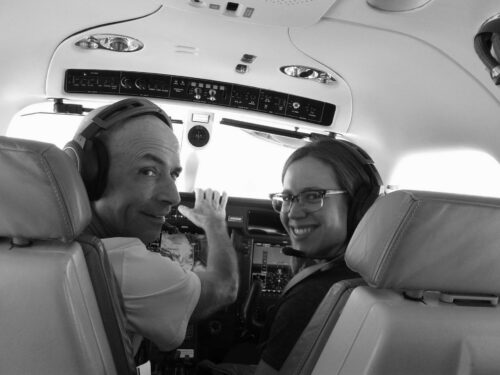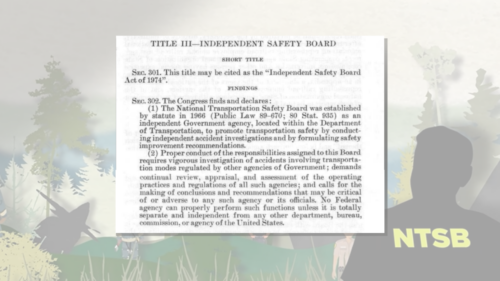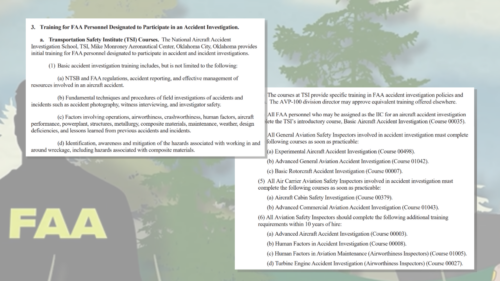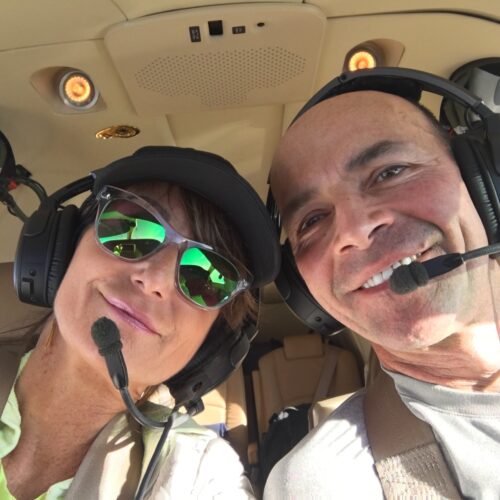By Emily Featherston, InvestigateTV; Joce Sterman, InvestigateTV
(InvestigateTV) — Just 19 minutes after Alaska Airlines Flight 1282 departed, a door plug behind the aircraft’s left wing suddenly blew out, causing rapid decompression in the cabin.
By the time the plane made an emergency landing and limped back to a gate — the event leaving the 171 passengers and six crewmembers shaken but alive — the wheels of the investigation into what went wrong were likely already in motion.
By law, the National Transportation Safety Board is to be notified immediately of any event involving civil aircraft in the United States, as the agency is tasked with investigating all such incidents and accidents to determine what happened and if there are ways to prevent it from happening again.
NTSB investigators were on the ground in Portland, Oregon and examining the Boeing 737 Max-9 in less than 22 hours.
But such a presence is not seen in the case of every aviation event — NTSB investigators are often absent from the scenes of crashes involving small aircraft, even when there is a loss of life.
InvestigateTV analysis of NTSB records found the agency only travels to a small fraction of all investigations each year, and over the last several years has left the on-scene work in the hands of the Federal Aviation Administration or others for roughly 1 in 5 fatal crashes.
During periods of difficulty, such as a federal government shutdown or the COVID-19 pandemic, the agency’s in-person presence has been even more limited.
Board documents indicate NTSB officials weigh a variety of factors when deciding where to go and when — some of them seemingly more focused on public perception than the severity of a crash: Will there be media coverage? Was a celebrity on board?

An excerpt from the NTSB’s regional investigation manual explaining the decision making process for the agency’s level of response to an aircraft event. (Source: NTSB, Graphic by InvestigateTV)
But NTSB officials assert priority is given to those events that would likely result in industry-wide safety recommendations.
They also have to wrestle with responding to more than 1,200 aviation events each year with an investigative staff of less than 100 and a budget that has remained relatively flat since the late 1990s.
Still, critics say not responding in person, especially to fatal crashes, threatens the independence of the NTSB. It was specifically designed by Congress to operate outside of the U.S. Department of Transportation to catch any safety issues or gaps in policy that could put the public at risk.
“There needs to be a very strong and strict firewall between the agency and the investigator, especially now when you have more cases of doors flying off and problems with planes,” said David Williams, president of Taxpayers Protection Alliance, a nonprofit that looks at government spending, transparency and efficiency.
The Alaska Airlines event in particular has reignited criticisms of the FAA’s own practice of outsourcing certain safety inspections to manufacturers themselves, but Williams and others say regardless of how things are going for that entity, the NTSB’s efforts should stand on their own.
“Consumers expect from the NTSB that they are independent, that they are separate from the FAA,” Williams said, “and it’s critical for consumers, for taxpayers and just for the flying safety of the public.”
It’s especially critical for the loved ones of those who are killed when something goes wrong between takeoff and landing.
‘I was horrified that they weren’t coming’
One crash that lacked an on-scene NTSB presence occurred on October 2, 2020, when the small plane piloted by prominent personal injury attorney Steve Barnes plunged to the earth about 17 miles short of its destination at the Buffalo, New York airport.
Barnes’ partner of 12 years, Ellen Sturm, was in the middle of preparing for a family party when she learned the person who meant the world to her was gone.
“He was everything to me,” she said. “I worked side by side with him. We climbed mountains together. We had family functions together. We were best friends in every sense.”
The plane crash also took the life of Barnes’s niece, Elizabeth Barnes, whom he was retrieving from New Hampshire so she could attend the small, pandemic-conscious celebration of Steve’s mother’s 90th birthday.

Steve Barnes pictured with his niece, Elizabeth, on a flight together in the months before an October 2020 crash that took both of their lives. Credit: Courtesy of Ellen Sturm
When he left for the round trip that was scheduled to take only a few hours, Sturm said he was excited about the chance to spend time with the family.
“He walked out, he said, ‘I love you. I’ll be home before noon with Lizzie,’” she said.
Normally, Sturm said Barnes would text her after landing and give her updates, but when she hadn’t heard from him by about 12:30 p.m., she said she began messaging him to ask where he was.
As she was preparing the meal for the ill-fated party, Sturm said she received a frantic phone call from her brother, a journalist.
“When I picked up my cell phone, my brother was like, ‘Ellen — you’re okay,’ and I just knew from his voice and I said, ‘What’s going on?’ and he just said, ‘Don’t turn the news on,’” she recalled.
Instead of a joyful celebration, the family was left planning two funerals.
“I don’t know if anybody can really appreciate how cruel fate can be that you would live until your 90th birthday and lose your son and your granddaughter on that day,” Sturm said.
As Sturm mourned, authorities combed through the accident scene. But one entity was noticeably absent — the NTSB.
The final report reviewed by InvestigateTV does not explain why the crash did not merit an on-scene response, but the agency told news outlets at the time it was due to limitations caused by the pandemic.
“I was horrified that they weren’t coming and doing a full investigation,” Sturm said.
Even calls by members of Congress for the NTSB to send an investigator on-site were left unheeded.
“It just it felt like you’re completely diminished at the worst time of your life,” Sturm said. “There’s these two incredible people and they’re just wiped off the planet, and isn’t this the organization that’s supposed to be in charge of, you know, airplane safety, aviation safety?”
‘Independence’ and a key decision: To go, or not to go?
By the numbers, air travel has consistently retained its status over time as the “safest” form of getting from one place to another.
Still, aviators dating back to the Wright brothers note there is always a risk that something will go wrong between takeoff and landing, the elder brother Wilbur remarking in 1901: “If you are looking for perfect safety, you will do well to sit on a fence and watch the birds.”
There are an average of three aviation incidents or accidents in the U.S. per day, the vast majority involving small, non-commercial aircraft, and fatal crashes occur roughly once every two days.
For every single one of those events, the NTSB is required by law to investigate in order to determine the probable cause and whether any safety recommendations need to be made to the industry or regulators.
Those investigations are meant to be done independently — meaning they are supposed to be done outside of the control of any other federal department.

An excerpt from the 1974 Independent Safety Board Act (Pub. L. 93−633) outlining the purpose of the NTSB’s independent status. (Source: GovInfo.gov; Graphic by InvestigateTV)
The NTSB was first created in 1967 as part of the U.S. Department of Transportation, but in 1974 was pulled out and re-established by Congress as a separate, independent entity charged with promoting safety in transportation by conducting investigations and making safety recommendations.
The law says that because the NTSB may need to make critical or adverse conclusions about DOT operations or policies and suggest changes, it had to be independent. “No federal agency can properly perform such functions unless it is totally separate and independent from any other,” the statute reads.
The law states that the NTSB is “responsible for the investigation, determination of facts, conditions, and circumstances and the cause or probable cause of all accidents involving civil aircraft, and certain public aircraft.” And while other federal, state or local agencies may be granted access to crash sites and evidence, the NTSB retains control and primary jurisdiction.
Events involving other modes of transportation — automobiles, railroads, pipelines and marine vessels — also fall under the agency’s purview, but the statute does not mandate “all” accidents be investigated in the same way that it does for aviation.
“Our job is to go out and to determine the facts, conditions and circumstances of each accident,” Joe Sedor, the chief technical advisor for the NTSB’s Office of Aviation Safety, said in an interview with InvestigateTV.
InvestigateTV analysis of NTSB investigation data from 2015-2023 found the agency initially designated an average of just 14.1% of all aviation investigations each year merited having NTSB staff at the scene.
In a majority of aviation events each of those years — roughly 70% — no one was hurt or there were only minor injuries, but the U.S. saw, on average, 215 fatal crashes annually.
Because the scope of the NTSB’s response could potentially expand or contract after a crash’s initial categorization is made, InvestigateTV and the Arnolt Center for Investigative Reporting reviewed the published investigation reports for all fatal events across 2015-2023 to determine whether an agency investigator traveled to the scene or not.
According to the data, on average the NTSB did not travel to the scene of at least 21.8% of fatal events each year.
div class=”flourish-embed flourish-map” data-src=”visualisation/17702613″><script src=”https://public.flourish.studio/resources/embed.js”></script></div> }
That figure includes 2020, when the agency opted not to travel to 77.3% of fatal events, including the one outside of Buffalo that killed Steve Barnes and his niece, citing pandemic restrictions on travel — even though guidance for federal employees allowed for “mission critical” travel, including for safety investigations.
InvestigateTV presented the NTSB with a list of multiple fatal events where it did not send an investigator to the scene, including several that occurred outside of the pandemic timeframe, but the agency did not provide answers about what circumstances influenced those specific decisions.
According to an agency spokesperson, as well as an NTSB investigation manual found by InvestigateTV, the list of things the agency considers when deciding whether to send investigators to the scene includes:
- The type of aircraft and the location of the wreckage,
- The number of fatalities or the extent of any injuries,
- The likelihood of public or media attention,
- The notoriety of pilots, crew or passengers,
- The existence of known safety issue or items of interest to board members,
- Early and extensive information about a probable cause.
“We look at each accident individually, because every accident is different,” Sedor said. “Even if it has similar circumstances there, it’s going to have its own unique aspects.”
‘It’s a disservice to the American public’
The NTSB as a whole has roughly 430 employees, and Sedor said the aviation office makes up about 120 of that total.
With a yearly load of investigations that outnumbers staff 10-to-1, Sedor said it’s often necessary to utilize outside resources though what’s called the “party system,” where the on-scene work is handled by other entities.
By law, the FAA is always granted status as a party, and aircraft manufacturers, state and local law enforcement and other subject matter experts also may provide assistance.
But even in cases where those parties are at the scene and the NTSB is not, Sedor said the agency still retains official control of the process.
“We do not delegate the investigation,” Sedor said.
Parties must sign a document acknowledging their responsibility to cooperate with NTSB investigators and follow agency policy and that they are prohibited from withholding any information they obtain during the investigation from the NTSB.
However, a 2000 study by the RAND Corporation, a nonpartisan policy research group, found while the party system works well enough in most cases, it has the potential to be compromised by the inherent tension between the NTSB and the FAA or the risk of civil litigation.
“This inherent conflict of interest may jeopardize, or be perceived to jeopardize, the integrity of the NTSB investigation,” the study report states.
Throughout his career spanning half a century, including almost a decade as an NTSB board member, John Goglia participated in countless aviation crash investigations — including the catastrophic TWA-800 explosion in 1996 that sent an airplane bound for Paris into the Atlantic Ocean.
Now, he offers his expertise in other ways, including through a flight safety podcast he started with other aviation experts where they discuss crash investigations and their takeaways.
Goglia said he believes the NTSB risks missing potentially critical details about what led to a crash when they don’t have an on-scene presence during an investigation.
“We often say [on the podcast] that the NTSB hit the big red easy button for some of the probable causes just to just to move it along,” he said.
Goglia said he takes issue with the inherent assertion that on-scene efforts by the FAA are equivalent to what would be done by an NTSB investigator.
In order to participate on-scene in the NTSB’s shoes, FAA employees must at minimum be employed at the Aviation Safety Inspector level and have taken the “Basic Aircraft Accident Investigation” course at the NSTB’s Transportation Safety Institute in Oklahoma City, according to an agreement between the two entities,. FAA employees are then required to take subsequent courses “as soon as practicable.”

Excerpts from an FAA document outlining the training requirements for personnel who participate in accident investigations. (Source: FAA document; Graphic by InvestigateTV)
By contrast, the minimum job requirements listed in a job posting for an NTSB Investigator are much higher, including having specialized experience leading or participating in multiple complex accident investigations.
“It’s a disservice to the American public because we don’t get all the benefits for the money that we’re spending for these investigations to bring the improvements,” he said.
Even though the FAA may share a similar goal of aviation safety with the NTSB, Williams with Taxpayers Protection Alliance said he too views the significant use of FAA personnel during the early stages of a crash investigation as a weakening of the NTSB independence taxpayers are supposedly paying for.
“An independent watchdog like the NTSB, has to be the lead investigator in this,” Williams said. “That’s why they need people on the scene.”
Like Goglia, Williams also said he had concerns about the training level of FAA investigators, and the two aren’t alone — the Government Accountability Office found gaps in the training practices in the FAA’s Office of Aviation Safety.
The 2020 report notes that while the agency provides training, it does not have processes in place to identify if its employees possess the critical competencies needed to carry out their jobs, nor does it regularly evaluate if its training curriculum is sufficient — something that Williams says only further emphasizes the need for NTSB investigators to be on-scene.
“There is no assurance that when FAA personnel go to a crash investigation, that they’re the right personnel to do this,” he said. “The NTSB is trained specifically for these situations and to investigate these situations.”
‘Undetermined reasons’
Despite taking the better part of two years, the investigation into the crash that killed Steve Barnes and his niece never found a definitive reason the single-engine aircraft seemingly fell from the sky.
“I still don’t feel like I know, and I know that the rest of the family feels like they don’t know,” Ellen Sturm, Barnes’s partner, said.
According to the final NTSB report, investigators found no evidence of any structural or mechanical failures that would have affected the aircrafts normal operations, and meteorological data reflect that the crash area was experiencing mostly clear skies with no concern for ice or turbulence.
The only apparent anomaly was a 25-minute lapse in contact between the aircraft and Air Traffic Control — but tower controllers were able to communicate with Barnes as he prepared to land.
The controller asked, “Is everything okay?” to which Barnes replied, “Yes sir, everything is fine.”
Based on a performance study done using data the FAA and the plane’s manufacturer, NTSB investigators determined that shortly after that response, the aircraft entered into a severe spiral dive toward the earth where it made impact, creating a 15-foot-deep crater.
The official probable cause determined by the NTSB for the October 2, 2020 crash is documented as: “The pilot’s failure to maintain control of the airplane for undetermined reasons during the descent to the destination airport.”

Ellen Sturm with her late partner, Steve Barnes. Sturm said they loved adventure and frequently flew together in the plane that was housed near the home the couple shared in Buffalo, New York. Credit: Courtesy of Ellen Sturm
Sturm said she remains beyond unsatisfied with the ultimate findings — especially because the NTSB did not have an investigator on scene.
“[Concluding] ‘He didn’t control the plane coming down for unknown reasons,’ that’s not helpful. Not really,” she said. “There could have been something mechanically wrong with the plane. I mean, they determined there wasn’t, but they didn’t bother to come and look at the evidence.”
NTSB staff did take a look at the recovered pieces of wreckage about six weeks after the crash, but Sturm said investigators should have been the ones to recover it in the first place.
“I think that they should have been there combing through that. They knew what to look for,” she said.
She said she believes it’s possible something could have been missed or mishandled.
“The data that was collected on scene and then the data afterwards — I believe that we determined the probable cause just as if we had been on scene, so we did not lose any information in that aspect,” Sedor, with the NTSB, said.
The day following the crash, when it became clear the NTSB was not planning to send an investigator to the scene, two New York Congressional representatives sent a letter to then-chair Robert Sumwalt, copying FAA administrator Steve Dickson.
Rep. Chris Jacobs (R) and Rep. Brian Higgins (D) implored the NTSB to travel to the site of the crash, saying: “Neglecting to do so leaves crucial information about what caused this tragic crash unknown.”
The NTSB told news outlets at the time “the decision to not travel to the scene included assessment of COVID-19 risks,” but the Associated Press confirmed the agency received the letter from the lawmakers.
NTSB records show investigators did launch to a fatal crash in Alabama five days after the crash that killed Barnes and his niece, and there were five other accidents that month labeled as “field” level investigations but that didn’t specifically indicate in the report whether the agency traveled to the scene.
“We did send people out when we needed to, but that’s again, [the pandemic] was just one more thing we had to think about,” Sedor said.
A lean agency
The NTSB hired 57 new employees in fiscal year 2023, bringing it to a total of about 430, and current board chair Jennifer Homendy has said the agency is hoping to hire roughly 15 additional new employees through 2027.
“It is critical for the agency to have additional resources to respond to events without impacting timeliness, quality, and our independence,” Homendy said in April 2022, when she first presented the agency’s budget requests to lawmakers.
On April 29, lawmakers announced a bipartisan agreement on language reauthorizing both the FAA and the NTSB that would give the independent agency $738 million over five years. That bill was approved by the Senate on May 9, and is awaiting action in the House.
But Homendy has also told lawmakers that to completely right-size the agency would take significantly more employees.
InvestigateTV contacted several lawmakers involved in aviation oversight —including House Transportation and Infrastructure Committee Chair Rep. Sam Graves (R-MO) and ranking member Rep. Rick Larsen (D-WA), as well as aviation subcommittee chair Rep. Garrett Graves (R-LA) and committee member Del. Eleanor Holmes-Norton (D-DC) — to ask about the NTSB’s level of on-scene response to aviation crashes and its resource needs, but none were available for interviews.
Multiple requests for comment were sent to Rep. Brian Higgins, one of the lawmakers who urged the NTSB to respond to the Barnes crash, before he left office in February, but InvestigateTV did not receive a response.
Meanwhile, there have also been calls for the NTSB to better use the resources it does have.
In August 2023, a GAO report found while the NTSB has been working in recent years to improve its processes, there is more that needs to be done.
“The more efficiently they use those resources, the better they can deliver on those missions,” said Heather Krause, managing director of GAO’s physical infrastructure team and lead author of the report. “Identifying inefficiencies is key. It could save lives. It could make the difference between finding safety flaws and not finding them.”
Yang Chao, Runtian Huang, Carson Johnson, Brookelyn Lambright, Yanai Levy, Martin Schauss, Tyler Spence and Jacob Spudich from the Arnolt Center for Investigative Reporting provided research assistance for this report.
Research Methodology:
InvestigateTV and the Arnolt Center for Investigative Reporting downloaded aviation event data from the NTSB’s CAROL database for all aviation events in the United States from Jan. 1, 2015, through Dec. 31, 2023.
NTSB training presentations and the documentation for the agency’s accident information database notes the identification number assigned to each investigation details the level of initial agency response using a two-letter identifier:
- FA: “Field” investigations, where at least one NTSB investigator travels to the scene to oversee examination of the crash site
- MA: “Major” field investigations where one or multiple NTSB investigators travel to the scene and are accompanied by one or more members of the board
- LA: “Limited” investigations where the NTSB coordinates on-scene examination remotely and evidence collection is handled by another party
By isolating those identifiers, InvestigateTV was able to determine the initial level of agency response for each event.
Looking at events where there was at least one fatality to determine whether or not an NTSB investigator traveled to the scene of an event, InvestigateTV and Arnolt Center researchers reviewed the PDF reports published in the CAROL database. The “Administrative Information” section generally includes notation about the level of on-scene response. Reports were marked “Yes” if the document explicitly noted the NTSB traveled to the scene, “No” if the report explicitly noted the NTSB did not travel to the scene, or “Unclear” if there was no note about on-scene presence or the note was not specific.
Calculations regarding the NTSB’s absence from a scene include only those events where the “No” was explicitly noted.


